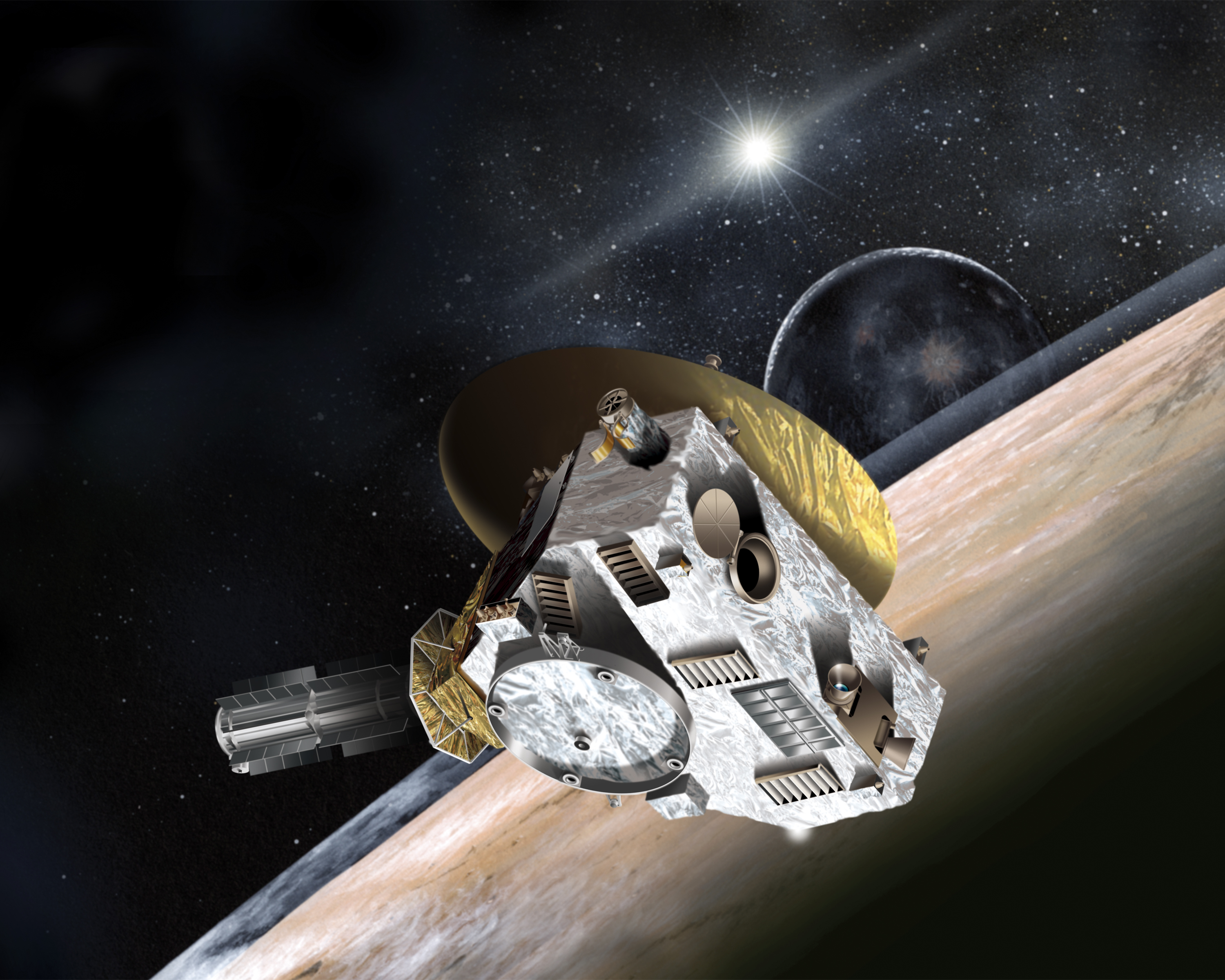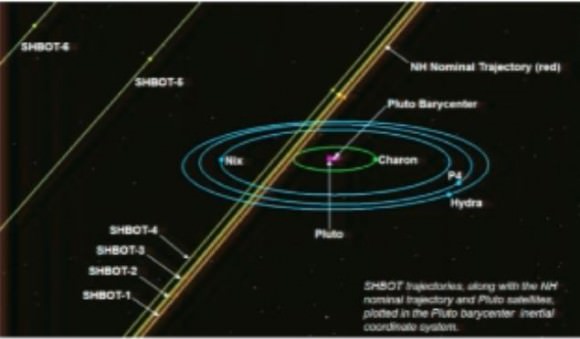Artist’s concept shows the New Horizons spacecraft during its 2015 encounter with Pluto and its moon, Charon. Credit: JHUAPL/SwRI
Since the New Horizons spacecraft left Earth back in 2006, there are a few things we know about the Pluto system now that we didn’t know then. For instance, it was discovered Pluto has two additional small moons – P4 and P5 — and Alan Stern, New Horizons Principal Investigator, said Pluto may have a large system of moons to be discovered as the spacecraft gets closer. There are also comets, possibly more dwarf planets and other objects out in the Kuiper Belt region where Pluto orbits.
“That’s exciting,” Stern said, “but this is a mixed story.”
Stern told Universe Today that while the spacecraft possibly could come upon an undiscovered moon or Kuiper Belt Object and they would have to alter course, the biggest issue is tiny debris which may be coming from impacts on the smaller moons.
“We could have 100 moons the size of P4 and they would not be a significant hazard,” Stern said via email. “The hazard is from ejecta coming off these satellites when they are cratered, because the ejecta escapes their feeble gravity and gets into orbit around Pluto.”
At a press conference at the American Astronomical Society’s Division for Planetary Sciences meeting, Stern said that with all the debris in the Kuiper Belt, objects are definitely getting impacted. “If hits occur on Pluto and Charon, they have enough gravity that ejecta just flies across the planet and creates secondary craters. But the ejecta on smaller moons puts shards and debris into the Pluto system.”
Stern said the ejecta speeds from these moons would be comparable to orbital speeds. That means the debris can orbit at any inclination, and there could be a cloud of debris around the system, creating a hazard for the spacecraft.
This worries Stern and his team.
“My spacecraft is going very fast and even a strike from something as small as a BB would be fatal,” he said. “There’s almost no place the spacecraft could get hit and it would be OK.”
Stern said current knowledge of the density of debris of the system can’t prove the spacecraft won’t get hit, and they won’t be able to find out more until they get closer.
“We’re going somewhere new and have no direct evidence of debris that could pose an impact hazard,” he said. “We don’t know what we are going to find and we might have to change our course.”
Stern and his team are looking at some alternative plans, and developing them now is crucial.
“When we plan an encounter for a mission like this, it literally takes tens of thousands of man-hours by experts to put that sequence together and test it,” he said. “We have to plan them now in order to complete that planning. We can’t complete them in the last couple of months or weeks.”
The plans being considered are called SHBOT: Safe Haven Bail Out Trajectory. They currently have nine different possible trajectories, depending on what they find as they get closer.
Screenshot from Stern’s presentation, depicting the nine SHBOT trajectories.
The team is also using every available tool — including sophisticated computer simulations of the stability of debris orbiting Pluto, giant ground-based telescopes, stellar occultation probes of the Pluto system, and even the Hubble Space Telescope — to search for debris in orbit.
Stern told Universe Today that they use the cameras on New Horizons itself every summer when they “wake up” the spacecraft. “LORRI (Long Range Reconnaissance Imager) has already seen Pluto for about 6 years!” he said, “But we won’t pass HST resolution till we’re about 10 weeks out, in April 2015. That’s when we turn on the heavy effort to look for more moons, rings, etc.”
They are looking at the pluses and minuses for each of the plans so they can be tested and be just as “bullet-proof” as the original, nominal flight plan.
In addition to saving the spacecraft, these alternative trajectories also need to preserve the science mission as much as possible. Most of the alternate courses bring the spacecraft farther away from the Pluto system, but one actually brings it closer to Charon, as the path there may be clearer there because of Charon’s gravity and clearing effect.
The spacecraft will start science observations in January 2015, with closest approach to the system currently set for on July 14, 2015 (“Bastille Day,” Stern said, “when we storm the gates of the Pluto system!”)
During the final 50 days of approach, when the spacecraft is taking pictures and sending them back to Earth to be analyzed, the team may discover something and have to fire the spacecraft engines, putting them on one of the SHBOT trajectories. But the last opportunity to actually change course is 10 days before encounter.
“After that we are in too close and we would run out of fuel and not complete the maneuver,” Stern said.
So, while the Mars Science Laboratory team had “Seven minutes of terror” during the perilous landing on Mars, Stern said they have something similar. “We don’t have seven minutes of terror; we have seven weeks of suspense.”



As a hobbyist, I’m just happy to see any higher res photos of Pluto taken before they may need to alter their direction. Would be a shame if they can’t complete the mission.
“My spacecraft is going very fast and even a strike from something as small as a BB would be fatal,”
I thought NASA and the tax payers of the United States officially owns the spacecraft 😛
I call my offspring “my” kids, but I don’t necessarily own them either 😉
‘My’ cat owns me!
I have a 17 year old blind cat and I’m officially her barcalounger…
I don’t think this can be more dangerous than the Voyager spacecraft passing through Saturn’s rings.
LC
Wow, that’s a good point. But how much more did we know back then about the likely composition of them in comparison to Pluto’s possible frenzy of flotsam… (though I suppose as the particles swarming around Pluto are ejecta, they would be considered jetsam). They seem to consider this a larger unknown, I suppose.
Did one of the Voyagers actually pass between the rings? I thought only Cassini tried that risky manouver. I remember being completely amazed that the mission planners chose that route. Amazing that it worked as well as it did.
All of the material surrounding Pluto makes me wonder of Charon is relatively young, and the smaller moonlets are the largest chunks of the debris left over from the Charon-creating impact.
Fantastic article, Nancy! I’m loving this mission more and more. What a perfect illustration of how science moves forward in fits and starts AND THAT’S HOW IT’S MEANT TO HAPPEN! I can only imagine the science nay-sayers jumping on this as more “proof” that the community doesn’t know what they’re doing. It only makes sense that more happens back here on Earth in the time it takes to get a pigeon to the other side of the ocean. From the moment one sets something off to such a distant goal… it’s frozen in time. To continue the analogy, we now know there may be a horde of hungry hawks swarming on the eastern seaboard. Time to consider Canada or the Florida Keys… While reading the article, it seemed like a very well thought out sci-fi story arch from some time in the past. I think it’s exciting no matter what happens. We’ll still be getting better and better science up to 10 days out then more in decline as planned, just not quite as much or as pretty-a-pictures. And there’s still the secondary and *maybe-maybe* tertiary targets to consider as well, if they play out to exist.
It would be a pity to have to waste fuel on an abort trajectory instead of keeping it for navigating encounters with more KBOs.